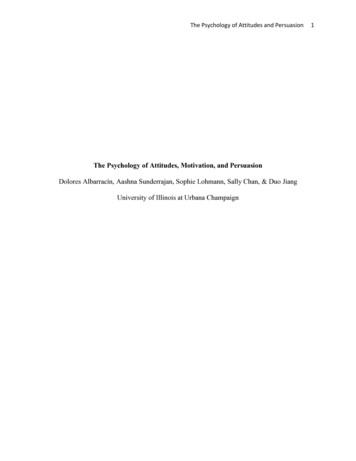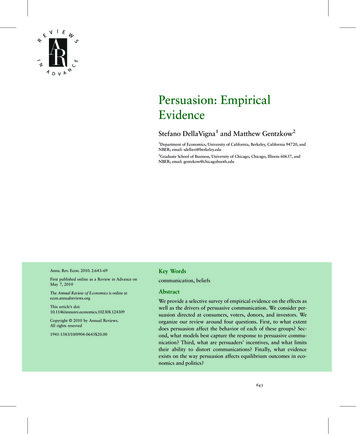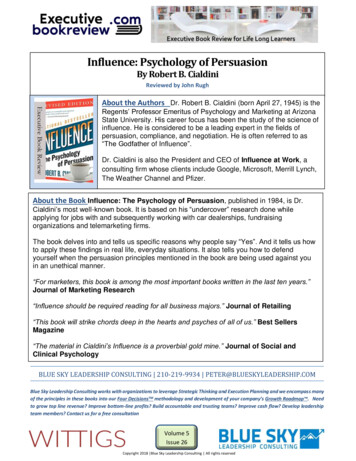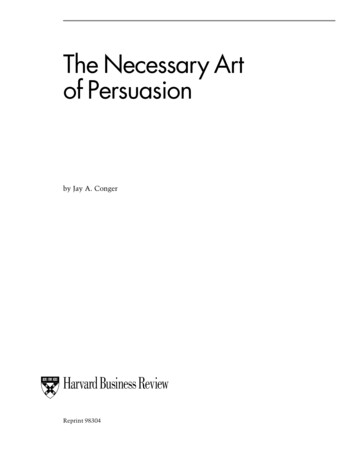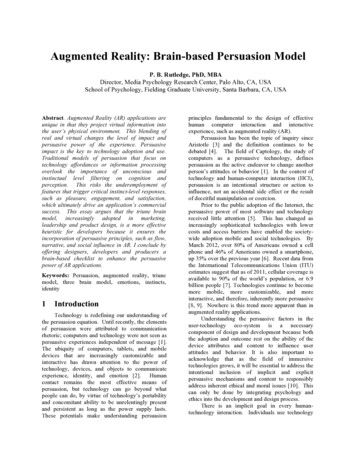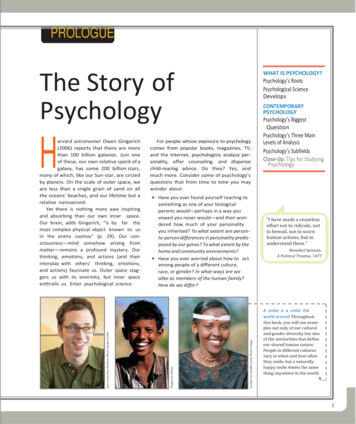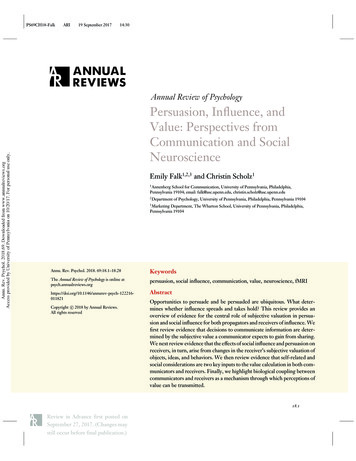
Transcription
PS69CH18-FalkARI19 September 201714:30Annu. Rev. Psychol. 2018.69. Downloaded from www.annualreviews.orgAccess provided by University of Pennsylvania on 10/20/17. For personal use only.Annual Review of PsychologyPersuasion, Influence, andValue: Perspectives fromCommunication and SocialNeuroscienceEmily Falk1,2,3 and Christin Scholz11Annenberg School for Communication, University of Pennsylvania, Philadelphia,Pennsylvania 19104; email: falk@asc.upenn.edu, christin.scholz@asc.upenn.edu2Department of Psychology, University of Pennsylvania, Philadelphia, Pennsylvania 191043Marketing Department, The Wharton School, University of Pennsylvania, Philadelphia,Pennsylvania 19104Annu. Rev. Psychol. 2018. 69:18.1–18.28KeywordsThe Annual Review of Psychology is online atpsych.annualreviews.orgpersuasion, social influence, communication, value, neuroscience, 1821c 2018 by Annual Reviews.Copyright !All rights reservedAbstractOpportunities to persuade and be persuaded are ubiquitous. What determines whether influence spreads and takes hold? This review provides anoverview of evidence for the central role of subjective valuation in persuasion and social influence for both propagators and receivers of influence. Wefirst review evidence that decisions to communicate information are determined by the subjective value a communicator expects to gain from sharing.We next review evidence that the effects of social influence and persuasion onreceivers, in turn, arise from changes in the receiver’s subjective valuation ofobjects, ideas, and behaviors. We then review evidence that self-related andsocial considerations are two key inputs to the value calculation in both communicators and receivers. Finally, we highlight biological coupling betweencommunicators and receivers as a mechanism through which perceptions ofvalue can be transmitted.18.1
PS69CH18-FalkARI19 September 201714:30ContentsAnnu. Rev. Psychol. 2018.69. Downloaded from www.annualreviews.orgAccess provided by University of Pennsylvania on 10/20/17. For personal use only.1. INTRODUCTION . . . . . . . . . . . . . . . . . . . . . . . . . . . . . . . . . . . . . . . . . . . . . . . . . . . . . . . . . . . . 18.22. THE ROLE OF VALUATION IN COMMUNICATION, PERSUASION, ANDSOCIAL INFLUENCE . . . . . . . . . . . . . . . . . . . . . . . . . . . . . . . . . . . . . . . . . . . . . . . . . . . . . . . . 18.42.1. The Communicator’s Perspective . . . . . . . . . . . . . . . . . . . . . . . . . . . . . . . . . . . . . . . . . . . 18.52.2. The Receiver’s Perspective . . . . . . . . . . . . . . . . . . . . . . . . . . . . . . . . . . . . . . . . . . . . . . . . . . 18.62.3. Open Questions About the Role of the Value System in Persuasionand Social Influence . . . . . . . . . . . . . . . . . . . . . . . . . . . . . . . . . . . . . . . . . . . . . . . . . . . . . . . . .18.113. SELECTED INPUTS TO THE VALUE COMPUTATION . . . . . . . . . . . . . . . . . . .18.113.1. The Value of Self-Relevance . . . . . . . . . . . . . . . . . . . . . . . . . . . . . . . . . . . . . . . . . . . . . . . .18.113.2. Social Relevance and Value Processing . . . . . . . . . . . . . . . . . . . . . . . . . . . . . . . . . . . . . .18.153.3. Open Questions About Inputs to the Value Calculation. . . . . . . . . . . . . . . . . . . . . . .18.174. BIOLOGICAL COUPLING AS AN INDEX OF SUCCESSFULCOMMUNICATION AND INFLUENCE . . . . . . . . . . . . . . . . . . . . . . . . . . . . . . . . . . . .18.184.1. Communication Between Pairs . . . . . . . . . . . . . . . . . . . . . . . . . . . . . . . . . . . . . . . . . . . . . .18.184.2. Synchrony Across Audiences . . . . . . . . . . . . . . . . . . . . . . . . . . . . . . . . . . . . . . . . . . . . . . . .18.194.3. Open Questions Relevant to Biological Synchrony and Communication . . . . . . .18.205. FUTURE DIRECTIONS . . . . . . . . . . . . . . . . . . . . . . . . . . . . . . . . . . . . . . . . . . . . . . . . . . . . . .18.205.1. Social Networks and the Brain . . . . . . . . . . . . . . . . . . . . . . . . . . . . . . . . . . . . . . . . . . . . . .18.205.2. Brain Network Dynamics Supporting Social Influence and Persuasion. . . . . . . . .18.215.3. Cultural and Environmental Determinants . . . . . . . . . . . . . . . . . . . . . . . . . . . . . . . . . . .18.215.4. Implicit and Explicit Motivations . . . . . . . . . . . . . . . . . . . . . . . . . . . . . . . . . . . . . . . . . . . .18.216. CONCLUSION . . . . . . . . . . . . . . . . . . . . . . . . . . . . . . . . . . . . . . . . . . . . . . . . . . . . . . . . . . . . . . . .18.211. INTRODUCTIONSubjective value:a person- andsituation-specificestimate of choicevalue (c) from theweighted average ofdifferently valuedchoice-relevantdimensions (d):SV(c) !weightd valued18.2People’s preferences and behaviors are strongly influenced by others. A daughter encourages herparent to stop smoking. A coach shares an inspirational news article to raise team morale. A person,let’s call her Emily, is more likely to take the stairs to her fifth-floor office if she is with her sportycolleague, let’s call her Christin, than if she is with colleagues who prefer the elevator. Knowingthat Emily respects Christin’s healthy lifestyle would also increase Christin’s willingness to activelyencourage Emily because she can expect Emily to think more positively of her and respond withappreciation rather than rejection. In parallel, knowing that Christin likes taking the stairs mightmake the personal health and social benefits of stair taking more salient to Emily than the ease oftaking the elevator.In this review, we argue that the diverse set of thought processes that determine what information communicators share (e.g., facts about smoking, an inspirational news article, encouragementto take the stairs) and whether receivers are influenced (e.g., to quit smoking, to train harder fora sport, to take the stairs) do so via a common pathway, namely subjective value maximization.Valuation involves explicitly and implicitly weighing perceived costs and benefits to derive thevalue of choices or actions and has been conceptualized as a motivating force for action (Bartraet al. 2013, Levy & Glimcher 2012). In other words, people make choices to maximize the valuethey expect from their actions. In this review, we examine the role of this broad class of valuecalculations in decisions to share information (Section 2.1) and susceptibility to influence in information receivers (Section 2.2). Among multiple person-level, social, and environmental factors,Falk·Scholz
PS69CH18-FalkARI19 September 201714:30The brain’s value systemCouplingCommunicator’s perspectiveAnnu. Rev. Psychol. 2018.69. Downloaded from www.annualreviews.orgAccess provided by University of Pennsylvania on 10/20/17. For personal use only.Self-relevanceSocial relevanceValuationReceiver’s perspectiveSelf-relevanceSocial relevanceValuationFigure 1Overview of persuasion and social influence from the perspectives of communicators and receivers. Thebrain image depicts the ventral striatum and parts of ventromedial prefrontal cortex from an automatedmeta-analysis of studies that involve the term “value.” Figure made using http://neurosynth.org.we highlight self-relevance (Section 3.1) and social relevance (Section 3.2) as inputs to the valuecomputation and neural coupling (Section 4) as a process through which subjective value may betransmitted between communicators and receivers (see Figure 1).Our argument is grounded in social science research on active forms of persuasion (e.g., tryingto convince a loved one to quit smoking or being persuaded by a public service announcement;for a review, see Albarracin & Shavitt 2018), more passive forms of social influence (e.g., takingthe stairs because others are doing it; for a review, see Cialdini & Goldstein 2004) and interpersonal contagion (e.g., sharing an inspiring news article; for a review, see Berger 2014). Coreaspects of prior theories in each of these domains have implicitly focused on people’s attempts tomaximize subjective value when making decisions about sharing information or being influenced.We highlight these elements and explicitly conceptualize each as a form of a more general classof value-based decision making. This conceptualization creates a bridge across prior theories, aswell as a concrete link to the previously disconnected literature on neuroscientific underpinningsof subjective valuation, which has served as a guiding force in understanding a more general setof choices and actions in other domains.Recent findings in neuroscience provide insights into how the brain calculates and representssubjective value in service of decision making (see Bartra et al. 2013, Clithero & Rangel 2014, Levy& Glimcher 2012). This neural perspective suggests that brain systems that calculate subjectivevalue represent a final common pathway or common currency through which different decisionalternatives (e.g., sharing one piece of information or another, taking the stairs or the elevator) canbe reconciled, prioritized, and realized in behavior and preferences (Bartra et al. 2013, Kable &Glimcher 2009). As such, conceptualizing persuasion and social influence in terms of value-baseddecision making complements and extends prior theorizing in fruitful ways.There are several other advantages to linking psychological and economic models of persuasion,social influence, and successful communication more broadly to neural models of value-baseddecision making. First, neural models offer a specific way to quantify the relationship betweeninputs to the subjective value calculation and the resulting decisions and actions. For example,expectancy value models of behavior change (Fishbein & Ajzen 2011) suggest that the overallprobability of choosing a particular option is determined by the average value of the expectedconsequences of each choice weighted by their likelihood of occurrence. For instance, Emily willbe more likely to take the stairs if she believes that the chances of a positive outcome, such aswww.annualreviews.org Persuasion, Influence, and ValuePersuasion: changesin preferences orbehaviors ininformation receiversconforming to activeattempts by acommunicator toencourage suchchangesSocial influence:changes in preferencesor behaviors resultingfrom passiveobservation of others’actions, inferencesabout others’perspectives, andbroader social normsValue-based decisionmaking: choiceselection based on theextent to which eachoption is positively ornegatively valued18.3
PS69CH18-FalkARI19 September 2017Annu. Rev. Psychol. 2018.69. Downloaded from www.annualreviews.orgAccess provided by University of Pennsylvania on 10/20/17. For personal use only.Reinforcementlearning: changes inthe choice likelihoodof a particular optionbased on expectedrewards andpunishmentsexperienced throughpast behaviorSocial learning:changes in the choicelikelihood of aparticular option basedon observed behaviors,rewards, andpunishmentsexperienced by others14:30bonding with Christin or positive downstream health effects, are highly probable results of takingthe stairs. In contrast, she will be unlikely to take the stairs if she expects the result to be arrivinglate and sweaty at a meeting on the fifth floor.Given the wide range of dimensions that inform the expected costs and benefits of a decision, itcan be difficult for individuals to self-report on the exact processes that lead to their choices. Neuroimaging provides a method of simultaneously measuring and quantifying a wide range of possibleinput dimensions to the subjective value calculation and, thereby, provides a different perspectiveon decision making processes. Measurement occurs in real time, as people are exposed to differentinformation, and without requiring the participant to consciously reflect on the processes that arecontributing to his or her decisions, preferences, or actions. Therefore, this neural evidence isagnostic to whether or not the processes in question are consciously accessible to the participant(Lieberman 2007); this is important because, as with many fundamental processes (Krumpal 2011,Wilson & Nisbett 1978, Wilson & Schooler 1991), motivations to share (Barasch & Berger 2014)and to update attitudes and behaviors in response to persuasion and social influence (Cialdini &Goldstein 2004) often occur automatically, outside of conscious awareness. Within this context,we refer to communicators who may intentionally seek to persuade (e.g., by trying to convince aparent to quit smoking), may share without explicitly identifying persuasion as a motive (e.g., bysending an inspirational news article), or may influence others indirectly through actions (e.g., byturning toward the door to the stairs out of habit without thinking about influencing a colleague).In parallel, we refer to receivers who may or may not be consciously aware of the communicator’s influence on them (e.g., actively considering the merits of an argument versus following acolleague up the stairs without explicitly thinking about it).2. THE ROLE OF VALUATION IN COMMUNICATION, PERSUASION,AND SOCIAL INFLUENCEDecisions both to communicate and to conform to the influence of others centrally involve subjective valuation. Within the brain, activity within the ventromedial prefrontal cortex (VMPFC) andventral striatum (VS) integrates multiple different inputs from other parts of the brain into a common value signal. This signal offers a means for comparison between different choices on a commonscale, which informs corresponding actions (see Figure 1). Importantly, this common value signalis not specific to one category of stimuli or choices and scales reliably with how much a person values a wide range of stimuli, including both primary (e.g., food, sex) and secondary (e.g., financial)rewards (Bartra et al. 2013, Chib et al. 2009, Levy & Glimcher 2012, McNamee et al. 2013). Byputting the universe of inputs on a common scale, the brain can make choices about which alternatives are subjectively more valuable in a given context (e.g., whether to take the stairs or the elevator,whether to eat an apple or a chocolate bar, whether to share or not share a piece of information).The value signal also accounts for past experiences to guide future behavior through the processof reinforcement learning. To do so, the brain computes a reward prediction error (Schultz 2006),tracking the difference between a person’s expected outcome (e.g., reward) and the actual outcomesof actions. When an action produces higher than expected rewards, it is seen as more valuableand reinforced, whereas when an action produces less reward (or more punishment or conflict)than expected, it is devalued; these changes in value also correspondingly guide future action. Asimilar principle guides social learning from the behaviors and outcomes observed in others. Inboth cases, choices with higher than expected (experienced or observed) rewards are more likelyto be chosen in the future, whereas choices with lower than expected (experienced or observed)rewards are less likely to be chosen in the future.One form of reward that may be especially relevant in the communication context comesfrom anticipated and received social approval. Because social connection is fundamental to human18.4Falk·Scholz
Annu. Rev. Psychol. 2018.69. Downloaded from www.annualreviews.orgAccess provided by University of Pennsylvania on 10/20/17. For personal use only.PS69CH18-FalkARI19 September 201714:30survival (Baumeister & Leary 1995, Lieberman & Eisenberger 2009), it makes sense that the brainwould reinforce successful communication strategies and conformity to group norms as ends inthemselves. This should be especially true to the extent that particular communication strategiesand conformity result in better coordination and stronger bonds between people (i.e., conforming helps me fit in with my friends). Within this framework, we conceptualize decisions to shareinformation as attempts to maximize the expected value to the communicator, with particularattention paid to anticipated social rewards. The expected value of sharing could be informedby the communicator’s own past experiences with information sharing or by the communicator’sobservations of the consequences when others share. In parallel, we conceptualize both persuasionand social influence as inputs to value-based decision making in receivers; the actions and recommendations of others provide broader information about the value of ideas, objects, and behaviorsto the receiver (i.e., if my friend likes it, it may have value to me), in addition to the social valueof conformity and social connection described above.As reviewed in greater detail below, core theories of persuasion, social influence, and behaviorchange have incorporated ideas about subjective valuation and value maximization under differentnames, highlighting, among others, beliefs about the consequences of behavior for oneself or selfinterest (Darke & Chaiken 2005, Fishbein & Ajzen 2011, Johnson et al. 2004, O’Keefe 2012). Inparallel, neural systems that are key to computing subjective value are robustly observed acrossstudies of sharing, persuasion, and social influence. Decisions to share information, as well assuccessfully persuading or influencing others, involve increased activity in the brain’s value system(Baek et al. 2017, Falk et al. 2013, Scholz et al. 2017b), and some have argued that humans mayfind intrinsic reward or positive value in sharing information with others (Falk et al. 2013, Tamir& Mitchell 2012). On the receiving end, social influence from peers (Campbell-Meiklejohn et al.2010; Cascio et al. 2015; Klucharev et al. 2009, 2011; Nook & Zaki 2015; Welborn et al. 2016;Zaki et al. 2011) and media (Chua et al. 2011; Falk et al. 2012a, 2013, 2016) changes the valuethat receivers ascribe to objects and actions.Consistent with social learning theory (Bandura 2001) and theories of embodied social cognition (Semin & Cacioppo 2008), recent evidence also suggests that synchronization betweencommunicators and receivers is a key component of successful persuasion and social influence,beyond the brain activity observed in either party alone (Scholz et al. 2017b, Stephens et al. 2010).Social learning, or using social information to update one’s own preferences and actions, is anefficient mode of learning (Bandura 2001), with conformity to group norms as a central, valuedcommodity that promotes approaching positive social outcomes (Cialdini & Goldstein 2004) andavoiding negative social sanctions (Fehr & Fischbacher 2004). Likewise, conformity and mirroringof others can promote positive relationships with others (Cacioppo & Cacioppo 2012), in partby activating social-cognitive and value systems in the person being mirrored (Cacioppo et al.2014).Conformity: changesin receivers’preferences orbehavior that are inline with those ofothers due topersuasion or socialinfluenceInformation sharing:transmission ofinformation fromcommunicators toreceivers with theimplicit (socialinfluence) or explicit(persuasion) goal toexert influence2.1. The Communicator’s PerspectivePeople share when they believe that information is valuable to the receiver (Barasch & Berger 2014,Berger & Milkman 2010, Reeck et al. 2016), valuable to the way that others will see them (Lampel& Bhalla 2007), or valuable to the relationship between the sharer and receiver (Clark & Kashima2007). Berger (2014) argues that sharing is motivated by five key factors: impression management,emotion regulation, information acquisition, social bonding, and persuasion of others (Barasch& Berger 2014). Each of these motives can be conceptualized as being valuable to the sharer, asthese motivations correspond to central human goals of holding a positive image of the self andmaintaining positive social relationships (Baumeister & Leary 1995, Mezulis et al. 2004, Taylor2006, Taylor & Brown 1988).www.annualreviews.org Persuasion, Influence, and Value18.5
PS69CH18-FalkARI19 September 201714:30Neural evidence also suggests that sharing recruits the value system and may offer a parsimonious way of quantifying and comparing various motives. In this view, opportunities to fulfill one ormultiple motivations associated with sharing could each increase the value of sharing information,either alone or in concert. These inputs could be weighed using the same context-dependent neural machinery (Cox & Kable 2014) that compares value in other domains (e.g., purchase decisions,mate selection) and increases the value signal associated with sharing a given piece of information,rather than sharing other information or not sharing at all. Empirical evidence supports this view.For example, the ideas that end up being shared most successfully are those that increase activityin the brain’s value system when potential sharers are first exposed to them (Baek et al. 2017, Falket al. 2013, Scholz et al. 2017a). More broadly, participants are willing to pay more money to shareinformation than to answer trivia, and the act of sharing also increases activity in the brain’s valuesystem (Tamir et al. 2015).Annu. Rev. Psychol. 2018.69. Downloaded from www.annualreviews.orgAccess provided by University of Pennsylvania on 10/20/17. For personal use only.2.2. The Receiver’s PerspectiveTheory and evidence support a key role for valuation in the receivers being socially influencedor persuaded. When incoming information changes the receiver’s perceived values of ideas andactions, the receiver is more likely to update their views or behaviors to be consistent with the message based on that value signal. For example, expectancy value theories of persuasion and behaviorchange suggest that people’s expectations of what will happen if they act and their evaluation of theexpected outcome determine, in part, whether and what action is taken (Fishbein & Ajzen 2011).Studies of argument quality similarly suggest that people are persuaded less by facts and more bysubjective value: “[T]he persuasive impact of argument quality, as it has been operationalized, ismuch less about logic than it is about valence. That is, persuasion is more about suggesting goodrather than bad consequences (valence) for the message recipient than it is about creating impeccablylogical—a.k.a. truthful or likely—arguments” ( Johnson et al. 2004, p. 216). O’Keefe (2012)further highlights the fact that a wide range of message effects that have traditionally been studiedseparately (e.g., gain versus loss frames, individualistic versus collectivistic frames, preventionversus promotion-focused appeals, fear appeals) all draw a connection between taking a specificaction and a subjectively valuable outcome or consequence (consequence-based arguments). Attheir core, these theories align with subjective expected utility models, which are central to abroad set of economic decision models (Samuelson 1937, Savage Leonard 1954, Von Neumann &Morgenstern 1944). Likewise, behavioral and neuroeconomic theories of decision making assumethat actors make decisions to maximize subjective value (Camerer et al. 2005, Levy & Glimcher2012).As such, conceptualizing persuasion in terms of value to the actor bridges psychological, economic, and neuroscientific perspectives on persuasion, influence, and behavior change. In particular, although psychologists typically do not assume that people know their preferences, northat these preferences are stable, theories in both psychology and economics have consideredways in which people assign value to ideas and act accordingly, with psychologists perhaps placinggreater emphasis on contextual factors (e.g., social norms, framing, attributes of the communicator, self-relevance in a specific context) as inputs to the value computation. In other words, thevalue assigned to a particular choice or action is subjective and takes into account a wide range offeatures that depend on the individual and social context. Likewise, neural evidence highlights akey role for valuation in conformity to social influence induced by perceived social norms and bypersuasive messaging and offers a specific and quantifiable signal tracking the process.2.2.1. Social influence and value in the brain. Neural evidence supports the idea that conforming to social influence implicates the brain’s value system. First, one set of studies points to18.6Falk·Scholz
Annu. Rev. Psychol. 2018.69. Downloaded from www.annualreviews.orgAccess provided by University of Pennsylvania on 10/20/17. For personal use only.PS69CH18-FalkARI19 September 201714:30the involvement of the brain’s value system in tracking divergence versus consensus with groupopinion; rather than tracking the value of the stimulus in isolation, some evidence suggests that thebrain initially tracks convergence and divergence with group opinion as an end in itself. In thesestudies, a participant’s brain activity is monitored during exposure to information about others’preference ratings, which either agree or disagree with an earlier rating made by the participant.Studies arguing for this first perspective suggest that activity is typically higher in the value systemduring consensus with others’ opinions than when participant opinions diverge from the group(but see Cascio et al. 2015). For example, in one early study, Klucharev and colleagues (2009) argued that social influence exerted by learning normative information (in this case, the preferencesof others) encourages and reinforces certain preferences and behaviors while discouraging others.Their core argument is that conformity to social norms (i.e., updating ratings to align with groupnorms) is driven by valuation processes that are similar to the type of reinforcement learningthat guides motivated behaviors more generally. In this study, participants rated the attractivenessof female faces and then received feedback about peer perceptions of the same faces. Later, theparticipants rerated the attractiveness of the faces. The team focused on brain systems known totrack value within the brain’s VS and the complementary capacity to detect conflict within partsof the medial frontal cortex. When participants’ beliefs about the attractiveness of female facesdeviated from the (experimentally manipulated) opinions of others, such deviations from the socialnorm correspondingly produced decreases in brain regions tracking value and increases in brainregions tracking conflict (Klucharev et al. 2009). The magnitude of this signal was associated withparticipants updating their own ratings of facial attractiveness to conform to peer norms. In asecond sample, the authors showed that the effects were stronger when participants believed thatthe group ratings were made by other people, compared to when participants believed ratingswere made by a computer, suggesting that conformity may be a form of reinforced social learning.In their example focused on facial attractiveness, deviations from the social norm triggered a prediction error tracking the difference between a person’s expected outcome (i.e., alignment withsocial norms may lead to social rewards) and actual outcomes (i.e., misalignment with the group)and caused participants to update their valuation of the faces.Other teams have also found evidence consistent with the idea that the brain monitors socialcues that indicate alignment and misalignment with group opinions during peer feedback andhave tracked these neural signals within brain systems associated with conflict monitoring andvalue (Berns et al. 2005, Tomlin et al. 2013). For example, agreement (versus disagreement)with expert opinions about music was associated with increased activity in the brain’s valuationsystem within the VS (Campbell-Meiklejohn et al. 2010, Cascio et al. 2015). Likewise, agreement(versus disagreement) with peer opinions about food was associated with increased activity in thebrain’s value system within the VMPFC (Nook & Zaki 2015). By contrast, nonconformity to peeropinions has been associated with increased activity in brain regions implicated in salience, arousal,and conflict monitoring (Berns et al. 2005, Tomlin et al. 2013), which the authors interpreted toindicate the saliency or negative arousal produced by going against peer opinions. This accountalso fits with the broader argument that conformity is first triggered by detecting divergence fromgroup opinion and arises as a result of learning in which alignment with group norms and valuesis reinforced and deviations produce conflict signals.A brain stimulation study offered further evidence for a causal role played by the conflictmonitoring component of reinforcement learning in conformity (Klucharev et al. 2011). In anexperiment similar to the team’s earlier functional magnetic resonance imaging (fMRI) studyof conformity, participants rated the attractiveness of female faces before learning about peerperceptions of the same faces; however, in this study, one group of participants made their initialratings and received peer feedback while undergoing brain stimulation [transcranial magneticwww.annualreviews.org Persuasion, Influence, and Value18.7
ARI19 September 201714:30stimulation (TMS)] to decrease activity within part of the posterior medial frontal cortex implicatedin conflict detection. Other participants completed the task under TMS within a control regionor under sham stimulation that did not alter brain activity but involved procedures similar tothose of the other groups. When participants later provided their final face ratings, those whoseneural conflict monitoring activity was downregulated during peer feedback showed significantlylower rates of conformity to peer feedback compared to the control and sham stimulation groups.Consistent with an account of conformity that emphasizes monitoring for potential conflicts withsocial referents, this study provides stronger causal evide
Annual Review of Psychology Persuasion, Influence, and Value: Perspectives from Communication and Social Neuroscience Emily Falk1,2,3 and Christin Scholz1 1Annenberg School for Communication, University of Pennsylvania, Philadelphia, Pennsylvania 19104;
